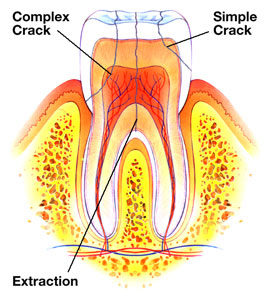Pain with Dental Origin
My dentist couldn’t find anything wrong with my tooth, but I still experience toothache. You are not alone. Our dentists in Brisbane often get patients with an exact similar problem to yours.
Your doctor is not lying to you he or she has examined your teeth, gum and mouth and checked your X-ray and did not find any problems. But it does not mean that nothing is wrong. The pain is still there, and you can feel it even though the cause is not found yet.
The origin of this unexplained and bizarre symptom can be dental or non-dental.
The real culprit can be an infraction. In this scenario, there is a crack in the tooth, but the parts are still together. The parts are not separated, and there is no decay. When the doctor was checking your x-ray, his or her eyes were searching for decay, but in your case, there are no caries. Perhaps your pain is caused by a thin, almost invisible fracture.
When you bite down on that cracked tooth, you may experience a nasty surge of pain. This is because your dentine spreads along that crack line. Some people experience this phenomenon as hypersensitivity. Others may experience it as constant pain.

How does a dentist approach fixing a cracked molar?
When a dentist approaches the treatment of a cracked molar, several factors are considered:
- Medical Factors:
- The Severity of the Crack: The first thing a dentist will assess is the extent of the crack. For example, a small hairline crack may be treatable with a filling or a dental crown, while a severe crack that extends down to the root may require a root canal or even extraction.
- The Location of the Crack: If the crack is located in an area that’s hard to reach or treat, the dentist may need to employ more complex procedures.
- Oral Health of the Patient: The dentist will also consider the patient’s overall oral health. For example, if the patient has gum disease, this might affect the treatment choice.
- Financial Factors:
- Cost of Treatment: Different treatments have different costs. A filling is generally cheaper than a crown, which is usually cheaper than a root canal or extraction followed by a dental implant. The dentist will usually discuss these options with the patient.
- Insurance Coverage: The patient’s dental insurance may cover some treatments but not others, influencing the treatment choice.
- Patient-Specific Factors:
- Patient’s Health Status: If the patient has other health conditions, particularly those that might affect healing or the ability to tolerate certain treatments (like diabetes or heart conditions), this will be considered.
- Patient’s Preferences: Some patients may prefer to avoid certain treatments due to personal preference or fear of certain procedures. Others may prefer more definitive treatments to avoid potential problems in the future.
- Age and Life Expectancy of the Tooth: The age of the patient and the expected longevity of the tooth (how long it’s likely to last with treatment) are also factors. For example, a young patient with a severely cracked molar might be a candidate for more aggressive treatment to save the tooth. In contrast, an older patient with a similar crack might opt for extraction and replacement with an implant (see dental implant cost in Brisbane).
Now, here are a few interesting facts about dental treatment for a cracked tooth that might surprise you:
- It’s Not Always Painful: One might assume that a cracked tooth would always be painful, but that’s not the case. Some cracks are so small that they don’t cause discomfort and are only discovered during routine dental exams.
- Cracks Can Be Hard to Diagnose: Sometimes, it can be tough for a dentist to determine the exact location of a crack, especially if it’s very small or located in a tricky spot. They might use special tools like dental dye or a transillumination test (shining a light through the tooth) to find it.
- Crowns Can Prevent Cracks: A dental crown, which covers the entire tooth, can sometimes be used not just to treat a crack but to prevent one from getting worse. This can be a great way to save a tooth that’s at risk.
- Teeth Are Amazingly Resilient: Despite the fact that we put our teeth through a lot of stress (chewing, grinding, exposure to hot and cold temperatures), it’s actually quite amazing how resilient they are. A small crack doesn’t mean a tooth is doomed — with the right treatment, it can continue to function healthily for many years.
How does a dentist detect a cracked tooth?
The process of detecting a cracked tooth involves several steps.
- Patient Symptoms: The process often starts with the patient reporting symptoms. These might include pain when chewing or biting, sensitivity to hot, cold, or sweet foods and drinks, and discomfort that comes and goes but is rarely continuous.
- Dental Examination: During a dental examination, the dentist will ask about the patient’s dental history and symptoms. The dentist might also ask the patient to bite down on a crack finder instrument to help identify the source of the pain.
- Visual Inspection: A visual examination of the teeth may reveal cracks, especially if they are large or visible to the naked eye. Dentists use a high-intensity light or a magnifying glass to inspect the teeth more closely.
- Dental Dye: A special dye can be used to make cracks more visible. The dye is applied to the tooth surface and then rinsed off. If there’s a crack, it will retain some of the dye, making it easier to see.
- X-Rays: Dental X-rays can sometimes reveal cracks in teeth. However, X-rays often do not show small cracks, so other detection methods may be more effective.
How does a dentist repair a cracked tooth?
The treatment for a cracked tooth depends on the size of the crack, its location, and whether it extends into the gum line. Here are the common treatments:
- Bonding or Dental Filling: For small cracks, a dentist might use a plastic resin for bonding or filling to repair the tooth. The resin is coloured to match the patient’s teeth, so it will blend in and appear natural.
- Dental Crown: If the crack is larger, a dental crown may be necessary. This involves removing the damaged part of the tooth and placing a cap, or crown, over the remaining part of the tooth. The crown is custom-made to fit the patient’s tooth and match the colour of the surrounding teeth.
- Root Canal Therapy: If the crack extends into the tooth’s pulp, a root canal may be necessary. In this procedure, the dentist removes the damaged pulp, cleans and disinfects the inside of the tooth, and then fills and seals it. Afterwards, a crown is often placed over the tooth to protect it and restore its function.
- Tooth Extraction: In severe cases where the tooth cannot be saved, the dentist or paediatric dentist may need to extract the tooth. Afterwards, options for replacing the tooth can be discussed, such as dental implants or bridges.
The above treatment options aim to prevent the spread of the crack, relieve pain, and restore the tooth’s function and appearance. Remember that it’s important to see a dentist if you experience any symptoms of a cracked tooth, as early detection and treatment can help save the tooth.
Is it OK to leave a cracked tooth?
Leaving a cracked tooth untreated is generally not recommended. Here are some reasons why:
- Pain: Cracks in a tooth can expose the inner layers, including the dentin and possibly the pulp, which contains nerves and blood vessels. This exposure can lead to sensitivity and pain when eating, drinking, or even breathing in cold air.
- Infection: The cracks can provide a pathway for bacteria to enter the tooth, leading to an infection of the pulp, a condition known as pulpitis. This can be quite painful and often requires a root canal treatment to resolve.
- Further Damage: If the tooth is left untreated, the crack may worsen over time, potentially leading to a complete fracture of the tooth. This can make treatment more difficult and may even lead to the loss of the tooth.
While some minor cracks, known as craze lines, which only affect the outer enamel may not require treatment, any crack that is causing symptoms or extends into the deeper layers of the tooth should be evaluated by a dentist.
What should I do if my tooth cracked?
Firstly, if you are experiencing any pain, you can take an over-the-counter pain reliever if you’re not allergic to it. You should also avoid eating on the side where the cracked tooth is to avoid any further discomfort.
Next, please book an emergency dental appointment as soon as possible. The dentist will need to examine the tooth to determine the severity of the crack and discuss the best treatment options for you.
Depending on the extent of the crack, there are several treatments we may consider:
- Dental Bonding or Filling: If the crack is minor and has not reached the pulp of the tooth (the part of the tooth that contains blood vessels and nerves), the dentist might be able to repair the tooth with bonding material. This is a tooth-coloured composite resin that can be shaped and polished to match the rest of your teeth.
- Crown: If the crack is more substantial but hasn’t reached the pulp, a dental crown might be the best option. A crown is a protective cap that covers the entire tooth, providing both structural support and a natural appearance.
- Root Canal Therapy: If the crack has extended into the tooth’s pulp, it may be necessary to perform a root canal treatment. During a root canal, the damaged pulp is removed, and the inside of the tooth is cleaned and sealed. Afterwards, a crown is typically placed over the tooth to protect it and restore its function.
- Tooth Extraction: In some cases where the tooth is severely damaged and cannot be saved, an extraction might be the best option. But don’t worry; there are several ways to replace an extracted tooth, including dental bridges, dentures, or dental implants.
Remember, these are just potential treatments. The best course of action will be determined after thoroughly examining your tooth. And remember, it’s perfectly okay to be feeling anxious about this, but rest assured we will do our utmost to make the process as comfortable and stress-free as possible for you. Our Sedation options include Happy Gas, IV Sedation and Sleep Dentistry using General Anaesthesia.
Cracked Tooth Treatment in Brisbane
A cracked tooth may be treated with a dental crown if the fracture has not extended into the pulp of your teeth. When a crack finds its way into the pulp, bacteria infect the nerve, and the case of a toothache can become more complex. It may or may not be possible to save the tooth when the fractured cusp is removed.
One option is to use a dental crown to contain the crack and prevent further extension of it. This solution may work for many years, but if the line extends to the root, it can cause an infection in the periodontal ligament and consequently cause toothache pain again.
To test the extension of the crack line in your tooth, our dentist may put a wet cotton roll in your mouth and ask you to bite down on it. If the presence of infection is evident, unfortunately, your natural tooth cannot be saved beyond this point.

In summary, signs for the diagnosis of a fractured tooth may include the following:
- No sign of decay in your X-rays (an X-ray is more accurate than an OPG)
- Pain when chewing food
- Pain when cold air is applied to your tooth
- Pain when sugar leaks into the fracture line
Diagnosis of a cracked tooth can be a frustration for both the patient and some inexperienced doctors.
References:

Pain with Non-Dental Origin
Going back to the original topic of this article, the source of an unexplained toothache can be non-dental.
In this scenario, a patient experiences an unexplained toothache and finds a dentist in Brisbane to address this pain. The patient consults several doctors and specialists and they advise him or her that there is no dental problem they can see. So, what is the cause of this persistent pain then?
In this scenario, your oral health is OK or you have completed required dental treatments and the pain still persists. Your pain also does not go away with dental anaesthetics. Your teeth have been positively found healthy, then the next step is to find the origin of this non-dental pain.
Symptoms that indicate pain origin may not be dental are:
- You feel the pain in several teeth
- You feel that the pain moves
- A tingling pain
- A burning pain
- No change in pain intensity
- Intermittent pain without any provocation
In this situation, it is recommended to consult with an orofacial pain dentist near you.





































